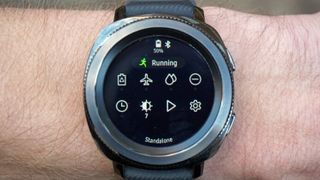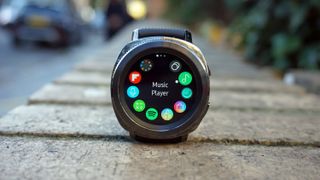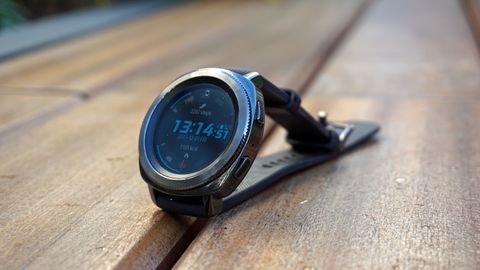Why you can trust TechRadar
Interface
The interface on the Samsung Gear Sport is rather fiddly, and that's mostly for one simple reason: the raise to wake isn't strong enough. You can leave the screen on, but that drops the battery life far too much.
It's just a case of trying to see the time, raising your wrist and nothing happening so often. And tapping the screen won't wake it, so you'll need to spin the bezel or hit a button to see what time it is. It's a fundamental flaw.
We like the idea of a spinning bezel to interact with the Gear Sport, but in reality it's still a bit fiddly if you're scooting through the interface. It's nice to spin it to dismiss a notification, but trying to bounce through different screens is tough and your hand almost gets in the way of seeing what you want.

Rotating the bezel is better for heading through lists, as the screen is too small to swipe on effectively, and that's where the physical mechanism comes into its own. However, for things like selecting apps it doesn't make it as easy... there's just something slightly unintuitive to the process.
It's something we got used to, but it didn't feel like the cleanest way of doing things.
That said, Samsung has improved the interface on the Gear Sport with the upgrade - things like the pull-down shade from the top of the watch's screen opening a set of quick action buttons was nice, and being able to rearrange them is really useful.
You'll also be able to use the spinning interface to control your SmartThings-enabled smart home soon - that's Samsung's own platform to let you monitor lights and heating, although it's annoying Bixby isn't on there to let you do the same thing.
The two buttons on the side of the Gear Sport generally make sense too - the top/back button operating as a way of pausing workouts takes some getting used to, and the bottom button is supposed to open apps and head back to the home screen, but sometimes we found we were unsure as to what was going to happen when tapping away.

It's inexplicable that Bixby isn't on this watch yet. There is 'S Voice', which is Samsung's rudimentary method of speaking to its gadgets from years gone by, but this isn't accurate enough as a wake up command, nor does it really do a huge amount, so we quickly stopped trying to use it.
And if you're using an iPhone (connecting to Apple's handset is a real fillip for Samsung and its smartwatches) you'll have to do little things like install the timer app when you actually just want to be reminded that your oven dinner is going to burn because you often fall asleep every evening.
iPhone connectivity is a nice touch though - it's nowhere near as good as compared to using a Samsung phone, with very basic app connections and lower battery life as a result of connecting to a slightly-incompatible OS, but overall the Gear Sport works well enough with alternative phones.
Battery life

One of the things that we loved about the Samsung Gear S3 is that watch had excellent battery life, with up to four days' use from a single charge.
The Gear Sport has a smaller battery (despite being heavier, for some reason) and yet inexplicably doesn't pack the same time between charges... it's down to about two and a half days between needing to put the Gear S3 in the dedicated wireless charging dock.
This little dock, connected by microUSB, is great at charging your watch, and if you plop it in the charger every two or three days you'll find that you rarely run out of juice.
What's maddening about this is that, as mentioned above, you don't really build up consecutive sleep tracking days, as you'll need to charge it overnight most of the time. If the battery life was four or five days it would be manageable, but this shorter time between charges really smarts.
Also, while the Gear Sport does charge using the Qi charging standard, you can't put it on a standard wireless charging block and hope that you'll get some juice... it just doesn't work.
We can't criticise the Gear Sport too much for battery life, as Samsung's Tizen operating system is one of the leanest and most efficient for a smartwatch.
However, we can’t see why the Gear Sport is worse for battery life than the Gear S3, and with raise-to-wake being so poor it's tempting to leave the always-on display running so you'll know the time... but this will see your battery life slide dramatically, as will constantly music streaming from your wrist.
Current page: A better interface, worse battery life
Prev Page Fitness Next Page Verdict and competiton
Gareth has been part of the consumer technology world in a career spanning three decades. He started life as a staff writer on the fledgling TechRadar, and has grown with the site (primarily as phones, tablets and wearables editor) until becoming Global Editor in Chief in 2018. Gareth has written over 4,000 articles for TechRadar, has contributed expert insight to a number of other publications, chaired panels on zeitgeist technologies, presented at the Gadget Show Live as well as representing the brand on TV and radio for multiple channels including Sky, BBC, ITV and Al-Jazeera. Passionate about fitness, he can bore anyone rigid about stress management, sleep tracking, heart rate variance as well as bemoaning something about the latest iPhone, Galaxy or OLED TV.

